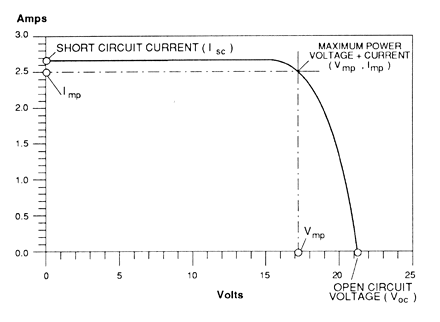Panel characteristics guide
Photovoltaic (PV) panels are bits of electrical equipment and as such they have key electrical characteristics that are defined by the materials that make it. These electrical characteristics basically describe how voltage and current vary for these particular devices. For PV panels this is most commonly represented by the graph below, the famous “knee curve”:

Knee curve (source).
This graph shows the four parameters that are used to describe any PV panel and that will be given on all datasheet and website listings.
Voc - The open circuit voltage is the maximum voltage that the PV panel can output under the test conditions (more on this below). This parameter is used as an indicator of what each panel could contribute to the voltage of the string of panels to make sure the inverter is suitable.
Vmpp - The voltage at the maximum power point. This is the voltage that would be expected from each panel if the panels are outputting at their maximum power point which an inverter, specifically the maximum power point tracker (MPPT), will attempt to do. This parameter is not used for sizing as it represents likely operating voltage rather than the highest voltage so is less crucial for sizing.
Isc - The short circuit current. The maximum theoretical current output from the panels is also used to ensure that the string of panels that’s used will operate within the safe boundaries of the inverter it’s connected to.
Impp - The current at the maximum power point. Similar to the Vmpp this is the current that the panel will likely be outputting for the majority of the time under the conditions specified.
STC - Standard Test Conditions
All of the above characteristics are given at STC which are given below:
- Cell temperature of 25°C
- Solar irradiance of 1000 W/m2
- Mass of air of 1.5
These are important to note because the characteristics of the panel will change as these conditions change so the datasheet is just giving a snapshot at pre-agreed conditions that allow for panels to be compared.
Temperature variation matters: The temperature will cause these Voc and Isc to vary so can affect sizing considerations. Consider a panel going up in Scotland where the temperatures can reach -10°C, you want to be confident that the electrical characteristics aren't going to stray outside the acceptable range for the wiring, isolators and inverter being used so relying on the STC at 25°C will not give the full picture.
The variation of these factors with temperature is something that’s provided by manufacturers on their datasheets as temperature coefficients which allow you to calculate the expected value at any given temperature.
NOCT - Normal Operating Cell Temperature
Some panel manufacturers also give ‘normal operating cell temperature’ (NOCT) that give a more realistic idea of what characteristics the panel might be expected to have. These are usually:
- Irradiance on cell surface = 800 W/m2
- Air Temperature = 20°C
- Wind Velocity = 1 m/s
- Mounting = open back side.
This accounts for the fact that when in direct sunlight the cells will almost certainly be above 25°C and so NOCT defines the surrounding conditions and then looks at how hot each panels cells get. This is useful for comparing panels as the key question is often; ‘will this panel give me more than that panel at this particular site?’ rather than ‘will this panel output more if it’s cells are kept at 25°C?’. NOCT values tend to be lower and so are not used for sizing in the same way that the STC values are.